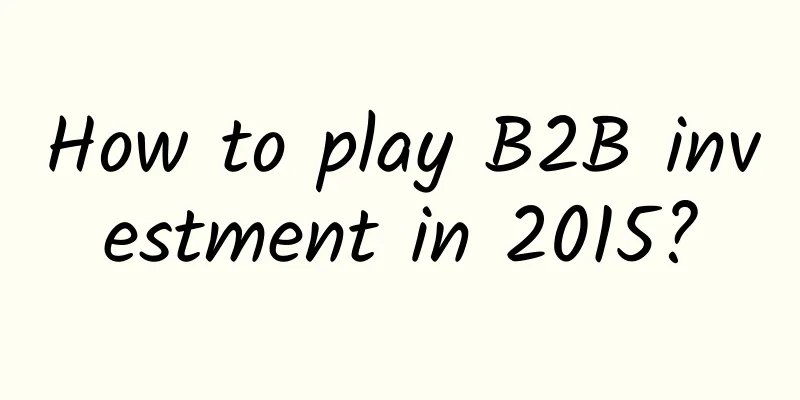How to play B2B investment in 2015?

|
2014 was the year with the most intensive capital movement in China's B2B industry. Alibaba acquired 100% of One-touch's equity, Huicong.com went public on the main board, Marco Polo.com received investment from Tencent's China South City, and Shanghai Ganglian increased its capital and expanded its shares in Ganglian E-commerce. Various mergers and acquisitions of all sizes took place in the industry, indicating that the industry reshuffle and consolidation have begun, and the best time to invest in B2B may be coming. However, most of the above events occurred within the industry. What opportunities do investment institutions have in this B-type capital carnival? Toby.com will sort it out for you and discuss it from three aspects: B-type investment threshold, future investment prospects, and industry and segment opportunities. 1. The development of Class B investment requires crossing many thresholds It is an indisputable fact that Class B investment is not active at present, mainly because Class B investment has many barriers, which involve the investment philosophy of investment institutions/investors, industry users' understanding of and insufficient investment in the Internet, and the fact that major industry platforms have completed listing and seem to be unprofitable, etc. Let’s first look at investment institutions and investors. Investors will more or less avoid Class B projects. The investment cycle and price-earnings ratio are two obstacles that cannot be overcome: Long investment cycle Unlike the hot investment in Class C companies, Class B companies are often considered to have a long investment cycle and limited exit methods, and exiting through IPO in China is almost a pipe dream. At the same time, the investment and development of Class C companies are extremely rapid, with rapid product evolution and investment iteration. Angel, A round, B round, C round, investment institutions participated enthusiastically and finally obtained the maximum benefits at the IPO. However, Cogolink, which belongs to Class B, completed its listing in three years, which surprised many investment institutions. The P/E ratio is not as good as that of Class C The embarrassment of the P/E ratio further highlights the overall pessimism of investors towards the domestic Class B market. This is extremely ironic – P/E ratio and corporate valuation are all about the future, and Class B companies that have maintained profitability for many years still seem to be unable to compare with the future imagination space of Class C companies. The audience of Class C companies is often all Chinese people, and even if the Chinese Internet population is divided into 80 or 90%, it is still an astronomical number. Class B companies, on the other hand, have a total audience of only 42 million companies, and what does selling fabric have to do with Foxconn? In terms of headcount, everyone thinks that Class B is dirty, tiring and unprofitable. But in fact, from the perspective of market capacity and scale, our views are completely different. I will discuss this later. In addition to concepts, investment institutions also lack solid industry basics to evaluate Class B projects. Insufficient understanding of the industry It has to be said that domestic investment institutions and investors also have a bias - the TMT industry (oriented to Class C). So when investment institutions and investors find it difficult to use Class C investment experience to examine Class B companies, the only thing left is to learn from the basics. Under this premise, how can you convince yourself and the investment committee to invest in such a project? Investment managers often have strong inductive and deductive abilities and their own investment methods. However, these laws are often not applicable when encountering Class B. It is impossible to find investment targets by forcing the answers, and it is difficult to form a new Class B investment methodology in the short term by abandoning this set of things, so Class B investment becomes useless. Let’s look at the long-standing problem of Category B – industry user habits. The local tyrants (stupid, big, black and rough) don’t understand the Internet How do B-type companies view their customers? C-type companies regard customers as God, as fans with emotional ties, and attach importance to user experience; while for B-type companies, we see two words - local tyrants (local hats). In the industry, especially in the manufacturing industry with a heavier business model, there is a more vivid word to describe this characteristic - stupid, big, black and rough. These B-type customers have not even completed the informatization and electronicization of their enterprises. What can we use to convince them to go online? In C-type, BAT has invested real money to educate people born in the 70s and 90s, and then helped them influence their parents and friends. In B-type, how do the 80s and 90s who are in lower positions convince the company's managers? Even the communication channels are problematic. It is impossible for children to influence their parents. In the Hongling Group, which was widely reported by the media not long ago, Zhang Dai's transformation was not even understood by his children. "Many people feel that this old man has some problems, and even his daughter advised him not to study this anymore." Now that all important third-party platforms have gone public, is there still opportunity for B2B investment? Finally, let’s look at the market situation. When it comes to B2B in China, many people think of Alibaba, HC360, and Global Sources. The leaders in these industries have basically completed their listings - there are indeed not many opportunities for such comprehensive B2B platforms. However, the listing of Cogobuy has made investment institutions begin to rethink how to invest in B-type companies. 2. Will Class B investment be the next hot spot? Toby.com is extremely optimistic about the investment future of Class B enterprises for four reasons: reference and inheritance of the rise of Class B investment abroad; the collision and integration of internal enterprise information needs and external Internet trends; huge market space; and the promotion of industrial Internet and Industry 4.0 concepts. When the C -type opportunities began to peak, investment institutions began to pay attention to the investment targets of the B-type. This trend change abroad has a subtle guiding significance for China. A feature of the development of the domestic Internet is that domestic enterprises will more or less inherit and copy the products and ideas of the other side of the ocean. In the C-type, this time interval is extremely short. It will take one month at the fastest and three months at the slowest for China's so-and-so to appear. At the level of mobile Internet, this speed is even shortened by several times. In some fields, it is not an exaggeration to say that it is synchronized. This law is also applicable to a certain extent in the investment field. Therefore, when CBINSIGHTS released a report stating that 80% of the listed technology companies in the United States in 2013 were B2B companies, many investment institutions and investors were more or less touched. CBINSIGHTS: More than 80% of listed technology companies in 2013 were B2B Class B investment lags behind Class C, so in about a year, domestic investment institutions have begun to focus on Class B investment opportunities. Toby.com has also experienced this. In recent months, many institutions have contacted us to recommend Class B investment targets. On the other hand, external stimuli are gradually coinciding with internal demands. Many domestic B2B companies are considering informatization and Internet transformation of their enterprises. There are two main categories of such transformations. One is to sort out the distribution links of enterprises, such as Haier's RRS and Pinsheng's same-day delivery; the other is to consider opening up incremental sales channels based on the Internet outside the original business system. The latter often does not make major offline layouts of distribution nodes, such as the use of logistics warehousing, but is realized through social third-party logistics and express delivery systems. In terms of implementation, the two-in-one model of platform and self-operation is often considered, so we often hear such lofty ambitions, "rebuilding a certain person". There is also a more systematic, radical and comprehensive way, that is, to transform all business processes of the entire enterprise, which is often the most difficult. Behind this individual push is a huge market space. In 2013, China's e-commerce transaction volume exceeded 10 trillion yuan, of which the B2B portion accounted for about 8.15 trillion yuan, accounting for 81.5% (Ministry of Commerce "China E-commerce Report (2013)"). The huge market share stimulates investors to find opportunities for success. In addition, slogans and guidelines such as Industrial Internet and Industry 4.0 will have a positive impact on B2B operators and leaders of traditional industries from the public level. When society and the media join the enlightenment team, it may not be so difficult to turn the trend into reality. Industrial Internet and Industry 4.0 are very high-sounding, but in Toby.com's view, to complete this step, it is still necessary to realize the informatization and Internetization of enterprises, which is what Class B businesses are currently doing. This is an opportunity for development. 3. Where are the future investment opportunities in B2B? The market has changed, so where are the investment opportunities in domestic B2B? Toby.com believes that there are opportunities in the following three aspects: platform models in vertical fields, self-operated models in vertical fields, third-party services, and data-based businesses. Among them, we are more optimistic about self-operated models and third-party services. Platform model in vertical fields The platform model in the vertical field refers to the model of providing third-party B2B platform services in a certain vertical industry market, such as Shanghai Steel Union and Yimutian. In the vertical platform model, Internet people are often the main driving force. When they first get involved in vertical industry business, Internet people often lack obvious advantages on one side of the industry. Through the construction of information platforms, they gradually become familiar with the industry and provide deeper services (transactions, finance). Shanghai Steel Union was similar to Alibaba B2B in the early days. It started with steel industry information and began to lay out its steel-silver e-commerce platform in 2013. At present, the steel-silver e-commerce business has become an important factor supporting the market value of Shanghai Steel Union. Yimutian's operation is more Internet-oriented. By convening official information officers, it has completed the construction of a huge information database and established industry advantages. The platform model in the vertical field focuses on serving the circulation value of the industry. As far as Toby.com knows, Yimutian has completed Class B investment, which shows that this type of platform model is being favored by capital. Self-operated model in vertical fields Unlike the platform model, the creation of the self-operated model often comes from existing practitioners in vertical sub-industries, who are often also industry leaders, such as Woyiguo and Cogolink. Take Cogolink as an example. Its predecessor, Cogolink Group, has been engaged in IC component distribution for nearly 20 years and has always been an important component distributor in the automotive electronics and FPGA fields. In Toby.com's view, inheritance is an important factor in Cogolink's successful listing. We can also see such elements in its financial statements. Major customers are the main source of revenue, which is inseparable from its history. Although the Internet model has given Cogolink a higher valuation, the industry precipitation behind it should not be ignored. For B2B startups with self-operated models, how much existing industry advantages can be mobilized not only determines the time required for success, but is even enough to affect whether this model can succeed. Deep involvement in the industry is an inevitable element for the success of the self-operated model, and factors other than operations have a greater impact on the success or failure of a project. The boss's original intention, internal coordination and resource allocation, and the setting and adherence to short-term goals are all extremely important. Does the boss want to raise the overall valuation of the group company, or is he determined to do such a project? Is it based on a transformation and acceleration of the company's internal business processes, or does he hope to recreate himself outside of the original business? What is the attitude of the company's relevant departments towards the new business, and whether they will invest resources to cooperate? Will an operational goal like three years of no profit become a profit for the group within half a year? For B2B startups with self-operated models, Toby.com believes that the power of investment institutions will help this type of startup, especially in helping entrepreneurs balance the boss's ideas and voice, so that such exploration can be sustainable. Third-party services This is a hot area in the B2B industry. However, this type of business is not in the start-up phase, but in the cash-out phase for investment institutions. We noticed that Alibaba completed the full acquisition of One-touch this year. As a comprehensive foreign trade service company, One-touch ranked among the top ten export companies in my country in 2014. In addition, Alibaba also completed the investment or acquisition of three companies at the same time: CITIC 21st Century, a comprehensive information and content service provider for the pharmaceutical industry; Shiji Information, a hotel information management system software supplier and technical service provider; and Hang Seng Electronics, a company that provides financial IT software to the financial industry. It should be pointed out that these three acquired companies are all engaged in Class B business. Huicong.com also completed the acquisition of Zhaoxin Information in October and carried out equity reforms such as management shareholding. Zhaoxin Information is a technology company mainly engaged in anti-counterfeiting technology and anti-counterfeiting products. At the B2B industry conference on May 27, 2014, we pointed out that in the post-platform era, China's B2B will seek new profit growth points through new traffic wholesale strategies. One of them is called pipeline control, which describes this behavior - "Pipeline control refers to B2B e-commerce platforms investing in, holding or even fully acquiring leading non-competitive assets in niche areas." It is a terrifying thing to create new value for the data and processed data of this pipeline. This is also an important reason why we particularly emphasize data services. HiChina is an example of a company that has come a long way. As early as 2007, Synnex invested in HiChina and became its major shareholder. However, this world-class distribution company did not achieve integration through HiChina and implement its distribution system in China. In 2009, Alibaba acquired HiChina and Synnex withdrew. However, HiChina's huge enterprise database brought a lot of customer resources to Alibaba's B2B business department. This is an important example of pipeline control in traffic wholesale. So, what opportunities do investment institutions have in this wave of investment dominated by B2B platforms? Toby.com believes that financial advisory and cash-out are two relatively mature opportunities. Take the acquisition of Zhaoxin Information by Huicong.com as an example. A Beijing investment institution played a matchmaking role in the middle. According to the rules of this type of business, it must have benefited a lot; on the other hand, investment institutions that invested in third-party services in the early stage also got the opportunity to cash out. At a time when it is difficult to list on the A-share market and foreign stock markets cannot understand the business, cashing out may be a safe way. With several years of experience in Class B investment, summarizing the methodology of Class B investment and looking for new investment opportunities in Class B may replicate its own success. In summary, among the above three investment opportunities, Toby.com is more optimistic about the self-operated model and third-party services in the vertical field. The self-operated model in the vertical field hopes that the investment institutions will become a balancer, helping traditional business owners and traders to reach a compromise, and helping projects with industry support to continue to develop; in the third-party service model, investment institutions are expected to reap past successes and sow new seeds. Today, Toby.com's evaluation of China's B2B market is: this is the best of times, but also the worst of times. The same may be true for China's B-class investment in 2015. via:2b |
Recommend
Five years after the launch of Insight-HXMT, hard X-rays reveal secrets of the universe
In June this year, the Insight-HXMT satellite cel...
[Smart Farmers] Why the beautiful Canada goldenrod became the "devil's flower"
Recently, an enthusiastic netizen posted a messag...
What are the side effects of drinking sour jujube leaves soaked in water?
Jujube is a food ingredient we are very familiar ...
Does poor sleep lead to a bad mood, or does a bad mood lead to poor sleep? Decoding the relationship between sleep and mood
Leviathan Press: There is a classic scene in the ...
Can myopia be controlled while sleeping? Are the "myopia magic tool" OK glasses really OK?
“Can orthokeratology lenses really delay the prog...
"Zu Chongzhi" is online! China's 176-bit quantum computing cloud platform is open to the world
Xinhua News Agency, Hefei, May 31 (Reporters Xu H...
The efficacy and function of cannon-blasted pangolin
The efficacy and effects of the medicinal materia...
The "purple" in front of you is not purple? What kind of purple are you talking about?
Recently, Zhang Chaoyang mentioned a statement in...
They killed 140,000 goats, and they said it was for ecological protection?
The gunmen on the two helicopters, armed with sho...
What are the dietary taboos of Rehmannia glutinosa?
When we take the medicinal material Rehmannia glu...
The efficacy and function of the sharp medicinal flower
The pointed medicinal flower is a medicinal mater...
Weird! Watermelon has grown bean sprouts
Recently, a woman in Kaifeng, Henan, was shocked ...
Can plantain be eaten as a vegetable?
The leaves of plantain are made into vegetables a...
Is low-sugar and low-fat ice cream worth eating?
Someone asked, a certain ice cream brand recently...









